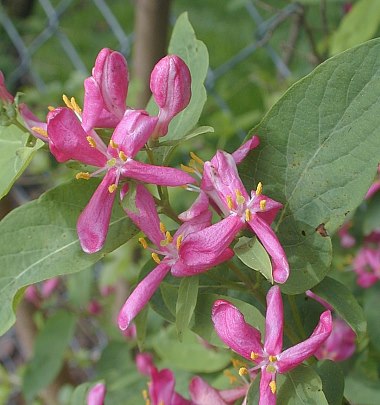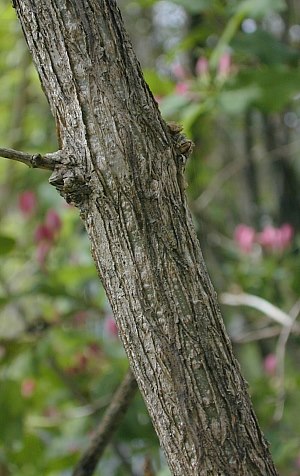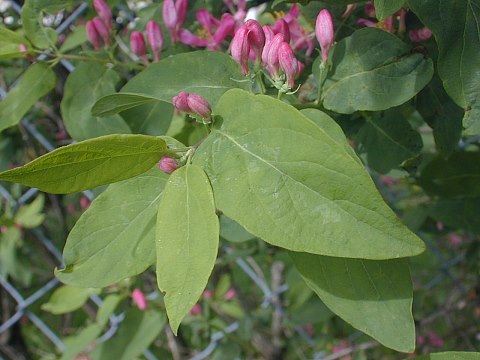Description: This multibranched shrub is 5-12' tall. The branches coming out of the ground are long and arching; they divide occasionally into smaller leafy branches, creating an irregular rounded crown. The bark of older branches is gray to grayish brown with narrow longitudinal ridges; with age, it becomes shaggy from shredded strips of bark The branches are often hollow and rather fragile. Young shoots are light green to reddish brown, glabrous to slightly pubescent, and terete. Pairs of opposite deciduous leaves occur along the shoots. Individual leaves are 1½-2½" long and ¾-1½" across; they are oval-ovate in shape and smooth along their margins. The base of each leaf is rounded to slightly cordate, while the tip tapers to a blunt point. The upper leaf surface is dull medium green, while the lower surface is pale green; both surfaces are hairless. The slender petioles are up to ½" long.

Pairs of white to
rosy pink flowers develop from the upper axils of the leaves. Each pair
of flowers has a slender pedicel about ¾-1" long. Individual flowers
are about ¾" long and ¾" across, consisting of a corolla with 5 lobes
that are long and narrow, a small green calyx (¼" long or less) with 5
spreading lobes, 5 stamens with while filaments and yellow anthers, and
a pistil with a single style. The stigma at the tip of the style is
green and globoid. The corolla is narrowly tubular at the base, but
flares outward into 5 spreading lobes that form poorly defined upper
and lower lips. The two upper lobes are often joined together at the
base. Underneath the calyx of each flower, there is a pair of small
linear bracts and even smaller bractlets (bracteoles); they are green
and hairless. The blooming period occurs from late spring to early
summer and lasts about 3 weeks. The flowers have a sweet fragrance that
is typical of honeysuckles. Afterwards, the flowers are replaced by
pairs of berries. At maturity, these berries are bright red with juicy
flesh. Each berry is about ¼" across and contains several small seeds.
The woody root system is shallow and spreading. This shrub spreads
primarily by reseeding itself.
Cultivation:
This shrub prefers partial sun, mesic conditions, and a fertile loamy
soil, but it is adaptable to other situations. The leaves unfold sooner
than those of other shrubs during the spring, and they persist until
late into the fall.
Range & Habitat:
Tatarian Honeysuckle is a non-native shrub that has naturalized in
many areas of Illinois. It is occasional in the northern half of
Illinois, but still uncommon in southern half of the state (see Distribution
Map). Habitats consist of deciduous woodlands, disturbed open
woodlands, woodland borders, thickets, fence rows, and roadsides. This
shrub is more common in suitable habitats near urban areas rather than
rural areas. Although less aggressive than Lonicera maackii
(Amur Honeysuckle), it is still invasive of natural areas, shading out
ground vegetation and displacing native shrubs. Tartarian Honeysuckle
was introduced into the United States from central Asia as a landscape
plant. Notwithstanding its invasive tendencies, this shrub is still
used as a landscape plant in various urban and suburban settings.
Faunal Associations:
The flowers are pollinated by the Ruby-Throated Hummingbird,
hummingbird moths (Hemaris spp.), and various bees.
Bees visitors include bumblebees, large carpenter bees, mason bees,
leaf-cutting bees (Megachile spp.), and green
metallic bees (Agapostemon spp., Augochlorella
spp., etc.). These floral visitors are attracted to either
the nectar, pollen, or both. Syrphid flies may feed on the pollen, but
they are too small to be effective pollinators. Other insects feed on
the leaves, plant juices, and other parts of honeysuckles
(Lonicera spp.), although it is unclear to what
extent this applies
to non-native honeysuckle shrubs in most cases. These insect feeders
include the aphids Alphitoaphis
lonicericola, Gypsoaphis oestlundi, Hyadaphis
foeniculi, and Hyadaphis tataricae. This
last aphid causes "witch's broom" on Tatarian Honeysuckle. Other
insect feeders include caterpillars of the moths Hemaris
thysbe (Hummingbird Clearwing) and Hemaris diffinis
(Snowberry Clearwing), and caterpillar-like larvae of the sawflies Zaraea
americana and Zaraea inflata. The larvae
of the wood-boring beetle, Agrilus cyanescens, bore
through the branches of honeysuckle shrubs. Among vertebrate animals,
the berries are eaten by Robins, Starlings, Cedar Waxwings, and other
birds; the seeds are distributed to new areas in bird droppings.
White-Tailed Deer appear to browse sparingly on honeysuckle shrubs.
These shrubs provide good cover for various birds and mammals.

Photographic
Location:
Along a fence row in Urbana, Illinois.
Comments:
In Illinois, this shrub should not be cultivated because it invades
natural areas and reduces biodiversity. An effective biocontrol agent
remains to be discovered. Tatarian Honeysuckle can be distinguished
from other honeysuckle shrubs by the color of its flowers (when they
are pink) and the lack of hairs on its leaves. During the fall, the
berries of Tatarian Honeysuckle are held on pedicels about ¾-1" long,
while other honeysuckle shrubs often have shorter pedicels (½" or
less). There is at least one cultivar of Tatarian Honeysuckle that has
reddish flowers.